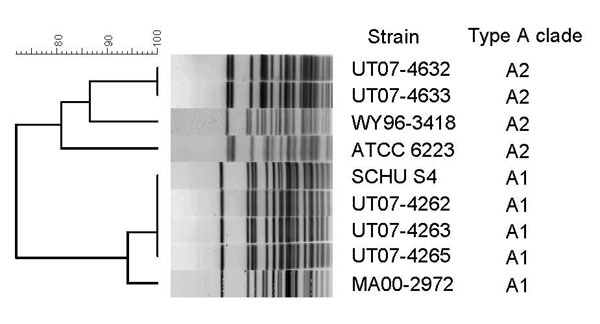Volume 14, Number 12—December 2008
Dispatch
Multiple Francisella tularensis Subspecies and Clades, Tularemia Outbreak, Utah
Figure 1

Figure 1. Dendrogram based on PmeI pulsed-field gel electrophoresis (PFGE) patterns of Francisella tularensis type A isolates. The dendrogram was constructed by using Dice similarity coefficients (1.5% optimization and 1.5% tolerance) and unweighted pair group method with averages. Strains WY96–3418, ATCC 6223, SCHU S4, and MA00–2972 were included as known A1 and A2 controls for creation of the dendrogram. Control strains were previously identified as either A1 or A2 by multiple methods including multilocus variable number tandem repeat analysis, PFGE, housekeeping gene sequence analysis, whole genome sequencing, and Indel analysis (1,2,4–7,9).
References
- Farlow J, Wagner DM, Dukerich M, Stanley M, Chu M, Kubota K, Francisella tularensis in the United States. Emerg Infect Dis. 2005;11:1835–41.PubMedGoogle Scholar
- Staples JE, Kubota KA, Chalcraft LG, Mead PS, Petersen JM. Epidemiologic and molecular analysis of human tularemia, United States, 1964–2004. Emerg Infect Dis. 2006;12:1113–8.PubMedGoogle Scholar
- Jellison WL. Tularemia in North America, 1930–1974. Missoula (MT): University of Montana; 1974.
- Johansson A, Farlow J, Larsson P, Dukerich M, Chambers E, Bystrom M, Worldwide genetic relationships among Francisella tularensis isolates determined by multiple-locus variable-number tandem repeat analysis. J Bacteriol. 2004;186:5808–18. DOIPubMedGoogle Scholar
- Svensson K, Larsson P, Johansson D, Byström M, Forsman M, Johansson A. Evolution of subspecies of Francisella tularensis. J Bacteriol. 2005;187:3903–8. DOIPubMedGoogle Scholar
- Larsson P, Svensson K, Karlsson L, Guala D, Granberg M, Forsman M, Canonical insertion-deletion markers for rapid DNA typing of Francisella tularensis. Emerg Infect Dis. 2007;13:1725–32.PubMedGoogle Scholar
- Nübel U, Reissbrodt R, Weller A, Grunow R, Porsch-Ozcürümez M, Tomaso H, Population structure of Francisella tularensis. J Bacteriol. 2006;188:5319–24. DOIPubMedGoogle Scholar
- Tularemia–USA (Utah. New Jersey) (02). Promed. 2007 Jul 18 [cited 2008 Oct 1]. Available from http://www.promedmail.org, archive no. 20070718.2304.
- Beckstrom-Sternberg SM, Auerbach RK, Godbole S, Pearson JV, Beckstrom-Sternberg JS, Deng Z, Complete genomic characterization of a pathogenic A.II strain of Francisella tularensis subspecies tularensis. PLoS One. 2007;2:e947. DOIPubMedGoogle Scholar
- Versage JL, Severin DD, Chu MC, Petersen JM. Development of a multitarget real-time TaqMan PCR assay for enhanced detection of Francisella tularensis in complex specimens. J Clin Microbiol. 2003;41:5492–9. DOIPubMedGoogle Scholar
- Kugeler KJ, Pappert R, Zhou Y, Petersen JM. Real-time PCR for Francisella tularensis types A and B. Emerg Infect Dis. 2006;12:1799–801.PubMedGoogle Scholar
- Barns SM, Grow CC, Okinaka RT, Keim P, Kuske CR. Detection of diverse new Francisella-like bacteria in environmental samples. Appl Environ Microbiol. 2005;71:5494–500. DOIPubMedGoogle Scholar
- Molins-Schneekloth CR, Belisle JT, Petersen JM. Genomic markers for differentiation of Francisella tularensis subsp. tularensis A.I and A.II strains. Appl Environ Microbiol. 2008;74:336–41. DOIPubMedGoogle Scholar
- Markowitz LE, Hynes NA, de la Cruz P, Campos E, Barbaree JM, Plikaytis BD, Tick-borne tularemia. An outbreak of lymphadenopathy in children. JAMA. 1985;254:2922–5. DOIPubMedGoogle Scholar
- Fang R, Lo E, Lim TW. The 1982 dengue epidemic in Malaysia: epidemiological, serological and virological aspects. Southeast Asian J Trop Med Public Health. 1984;15:51–8.PubMedGoogle Scholar
Page created: July 22, 2010
Page updated: July 22, 2010
Page reviewed: July 22, 2010
The conclusions, findings, and opinions expressed by authors contributing to this journal do not necessarily reflect the official position of the U.S. Department of Health and Human Services, the Public Health Service, the Centers for Disease Control and Prevention, or the authors' affiliated institutions. Use of trade names is for identification only and does not imply endorsement by any of the groups named above.